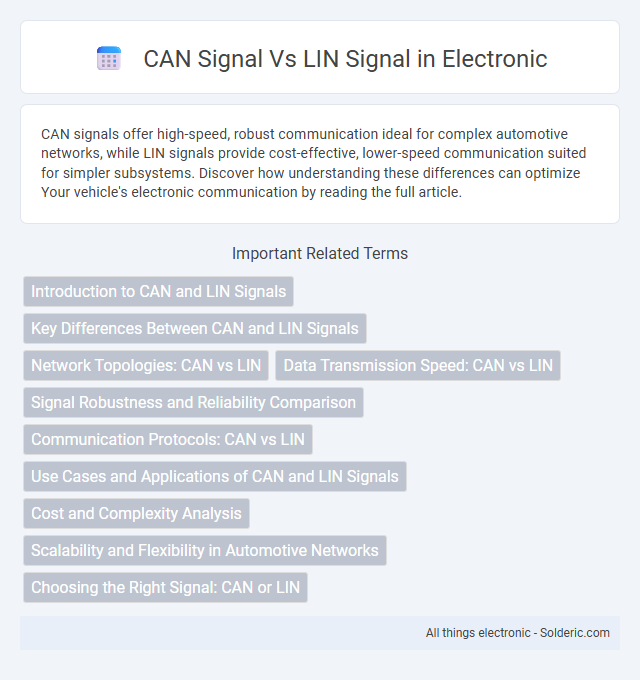CAN signals offer high-speed, robust communication ideal for complex automotive networks, while LIN signals provide cost-effective, lower-speed communication suited for simpler subsystems. Discover how understanding these differences can optimize Your vehicle's electronic communication by reading the full article.
Comparison Table
| Aspect | CAN Signal | LIN Signal |
|---|---|---|
| Protocol Type | Controller Area Network (CAN) | Local Interconnect Network (LIN) |
| Data Rate | Up to 1 Mbps | Up to 20 Kbps |
| Signal Type | Differential (CAN_H and CAN_L) | Single-wire, single-ended |
| Topology | Multi-master, bus topology | Single-master, multi-slave, bus topology |
| Complexity | Higher complexity, robust error handling | Simpler, designed for low-cost applications |
| Error Detection | Advanced error detection and fault confinement | Basic error detection |
| Use Case | Critical automotive systems, real-time control | Non-critical automotive subsystems, comfort electronics |
| Message Arbitration | Priority-based arbitration on bus | Master controls message scheduling |
| Cabling | Twisted pair cables | Single wire cable |
| Cost | Higher cost, more hardware required | Lower cost, simpler hardware |
Introduction to CAN and LIN Signals
CAN (Controller Area Network) signals enable robust, real-time communication between microcontrollers in automotive and industrial systems by using differential signaling for noise immunity. LIN (Local Interconnect Network) signals offer a cost-effective, single-wire communication protocol designed for simpler, lower-speed networking tasks in vehicles, such as window and seat controls. Understanding these fundamental differences helps you select the appropriate network protocol based on speed, complexity, and reliability requirements.
Key Differences Between CAN and LIN Signals
CAN signals operate with differential voltage levels over twisted-pair cables, ensuring high immunity to electromagnetic interference and supporting high-speed communication up to 1 Mbps or more. LIN signals use a single-wire, single-ended voltage line, typically operating at lower speeds up to 20 kbps, designed for simple, cost-effective communication in body electronics. CAN supports multi-master arbitration and complex protocols, while LIN employs a master-slave architecture with a simpler data frame and less error checking.
Network Topologies: CAN vs LIN
CAN networks utilize a bus topology where multiple nodes connect to a single communication line, enabling robust, high-speed data exchange and fault tolerance. LIN networks operate on a master-slave topology with one master controlling up to 16 slave nodes via a single wire, optimizing cost and simplicity for lower-speed communication. Your choice between CAN and LIN should consider the required data rate, network complexity, and fault tolerance needs.
Data Transmission Speed: CAN vs LIN
CAN (Controller Area Network) signals offer significantly higher data transmission speeds, typically ranging from 125 kbps to 1 Mbps, enabling rapid communication between automotive components in real-time applications. LIN (Local Interconnect Network) signals operate at much slower speeds, generally up to 20 kbps, suitable for simpler, low-cost sensor and actuator networks. The higher speed of CAN supports complex systems requiring immediate data exchange, while LIN's lower speed targets less critical, secondary control functions in vehicles.
Signal Robustness and Reliability Comparison
CAN signals offer higher robustness and reliability due to their differential signaling and error detection mechanisms, making them resilient to electromagnetic interference and faults. LIN signals operate with single-ended communication, which is more susceptible to noise and less error-resilient, limiting their use to less critical applications. CAN's multi-master protocol and cyclic redundancy checks ensure continuous data integrity, whereas LIN relies on simpler master-slave arbitration with basic error detection.
Communication Protocols: CAN vs LIN
CAN (Controller Area Network) and LIN (Local Interconnect Network) are communication protocols designed for automotive and industrial applications with different scopes and complexities. CAN supports high-speed, multi-master communication with error detection, arbitration, and data integrity, making it suitable for real-time control and critical systems. LIN is a low-cost, single-master, slow-speed protocol optimized for simple body electronics like door locks and climate control, offering basic network management without the robust features of CAN.
Use Cases and Applications of CAN and LIN Signals
CAN signals are widely used in automotive systems for real-time, high-speed communication between critical components such as engine control units, antilock braking systems, and airbags due to their robustness and error-handling capabilities. LIN signals serve as a cost-effective solution in automotive sub-systems like door modules, seat controls, and interior lighting where lower speed and simpler communication protocols suffice. Industrial automation and heavy machinery also heavily rely on CAN signals for reliable data exchange, while LIN signals are preferred for less complex and lower-cost components within embedded systems.
Cost and Complexity Analysis
CAN signals require more complex hardware and higher implementation costs due to their robust error handling and higher data rates suitable for critical systems, whereas LIN signals offer a simpler, cost-effective alternative with reduced complexity tailored for low-speed, less critical automotive applications. The cost efficiency of LIN comes from single-wire communication and minimal wiring harness requirements, significantly lowering installation and maintenance expenses. CAN networks demand more sophisticated controllers and transceivers, increasing upfront costs but providing scalability and reliability essential for larger, safety-critical vehicle networks.
Scalability and Flexibility in Automotive Networks
CAN signal offers high scalability and robustness, supporting multiple nodes with real-time communication essential for critical automotive functions. LIN signal provides flexibility for low-speed, cost-effective applications, enabling simple sensor and actuator integration in less complex networks. Your vehicle's network design balances CAN's scalability with LIN's adaptability to optimize overall system performance.
Choosing the Right Signal: CAN or LIN
Choosing between CAN and LIN signals depends on your system's complexity and communication needs, with CAN offering high-speed, multi-node data exchange suitable for real-time control in automotive and industrial applications, while LIN provides a cost-effective, single-master, single-slave network ideal for simple sensor and actuator connections. CAN signals support robust error detection and fault confinement mechanisms, enhancing reliability in critical systems, whereas LIN signals prioritize simplicity and low cost, making them perfect for non-critical, lower-speed environments. Understanding your network's performance requirements and budget constraints will guide you in selecting the right protocol for seamless, efficient communication.
CAN signal vs LIN signal Infographic

 solderic.com
solderic.com